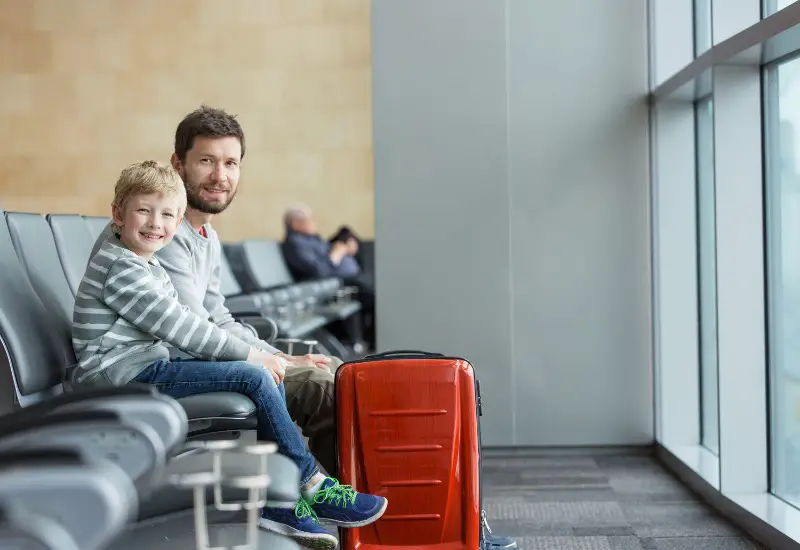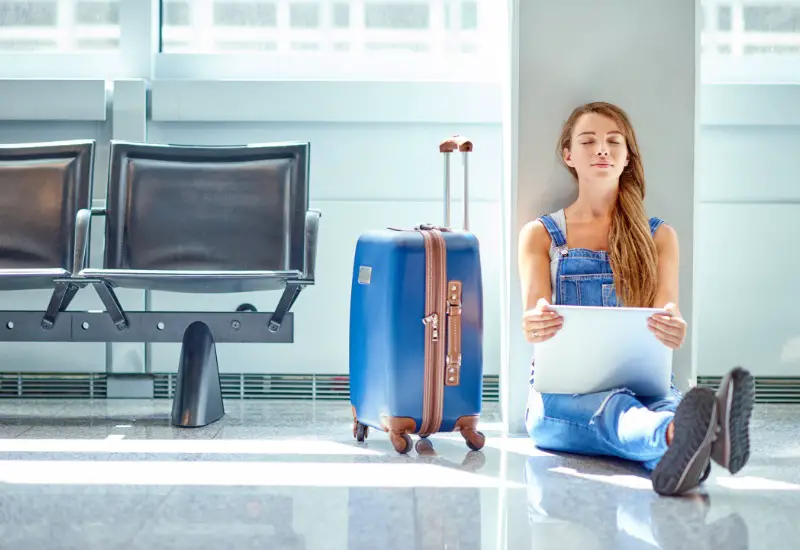As a Southwest flight attendant with six years of experience, I’ve seen many travelers grapple with the question: “How long should a layover be?” Layovers, whether they’re part of a dream trip to the Maldives or a lively Thanksgiving gathering with your extended family, are a staple in travel, particularly for those opting for budget-friendly tickets.
In this comprehensive guide, I’ll explore essential layover-related questions. You’ll find answers to common queries like “Is an hour enough for a layover?”, “Do layovers require going through customs?”, and “Are 40-minute or 30-minute layovers sufficient?” I’ll also cover the differences between international and domestic layovers and share tips on managing short layovers.
Table of Contents
Understanding the Basics
What is a Layover?
A layover is a stop between flights, where passengers temporarily disembark before continuing to their final destination. It varies in duration and may require a change of planes.
As flight attendants, we say layover to mean our overnight stay in a city while on our work trips, but for regular travelers, a layover time can be as short as 30 min, but in some cases, as long as overnight stays.
What Are the Benefits of Layovers or Connecting Flights?
So much, yes! While sometimes seen as an inconvenience (“but I wanna be in the beach right NOW”), there are actually solid benefits to layovers!
✅ Stretching!
Chances are, you need to stretch.
And I don’t mean annoying the flight attendants with galley yoga. I mean, a nice, full-body stretch off the plane.
It’s also beneficial for your cardiovascular health to spend some time walking around and get the blood moving in those legs in between long stretches of sitting.
✅ Hit Up A Lounge
I love airport lounges!
You can brush your teeth, change your clothes, take a cat nap to help mitigate jet lag, and even shower in some locations.
✅ Recharge
Airports also offer Wi-Fi, food/refreshment options, and sometimes yoga/meditation rooms and chapels, so you can take an opportunity to mentally and physically recharge before the next flight!
✅ Travel Delays
One benefit to layovers is that they act as a great buffer against travel delays.
If your initial flight is delayed for weather, maintenance, etc. a longer layover might be the reason that you don’t miss your connecting flight.
✅ Explore a New City!

Sometimes your layover is long enough to venture out of the airport.
I’ll cover which situations are the best for this later in the article, but here are a few ideas for exploring a new city in a short amount of time:
- Take a walking tour. Lots of cities offer short 1-3 hour walking tours of the downtown by a local guide. This is a great way to soak up a lot of culture and information in a short amount of time.
- Shop! What a great opportunity to snag something you may have forgotten for your trip. Maybe a sweater or scarf in the local style of fashion is calling to you.
- Grab some local food. Another opportunity for a new experience! You might get to try a different kind of cuisine you may have never planned on trying.
Can I Book My Own Layover or Does the Airline Do It for Me?
Both are viable options!
Booking your own layover can leave you with a little more flexibility. This opens the doors to finding less expensive routes by having access to multiple airlines instead of just one. But how much time is enough time to book yourself?
On the other hand, if the airline chooses your layover for you, it simplifies the booking process, making it convenient and hassle-free. You won’t have to worry about the logistics of planning the layover, and the airline will ensure your connecting flights are well-coordinated.
However, if you decide to book your own connection, here’s some tips.
Guide to Book Your Own Layover

Choosing Layover Durations
Minimum Layover for a domestic flight
I would never recommend that anyone book a layover under 1.5 hours. While 1 hour might be acceptable for domestic flights at smaller airports, it may feel tight or rushed.
Minimum Layover for an international flight
As a general rule, I would never book less than 3 hours.
International travel typically involves additional processes such as customs and immigration, which can be time-consuming.
A 3-hour layover offers a safer margin to accommodate these procedures and any potential delays, ensuring a smoother transition to your connecting flight.
However, depending on the specific airport and your familiarity with the layout and procedures, you might occasionally manage with a shorter layover.
Factors to consider when booking your own layover
Taxiing and Occupied Gates
Sometimes airports out there have insanely long taxi times (the time it takes to get to the gate after land), up to a half hour (yes ORD, that’s you).
And even when you get to your gate, the previous plane might still be sitting there because of a short delay for any reason.
This can eat right into layover time.
Deplaning
This can take literally forever.
I’m not being dramatic! 💁🏽♀️ Okay, a little bit, but a full plane of passengers, especially on a jumbo jet, trying to de-board is going to take some time, maybe up to a half hour if you’re not seated near an exit.
Pro tip: Try to check in as early as possible to pick your own seat closest to a boarding door.
Luggage
In some cases, like if you’re switching airlines or going from an international to a domestic flight in a new country, you will have to collect your luggage at baggage claim and re-check it.
This can eat up a huge chunk of time while you wait at the carousel for your luggage.
Changing Terminals
Just like you might have to claim and re-check luggage in certain situations, it’s very possible that you’ll have to change terminals. This could even involve leaving security! Which brings me to the next point.
Downside
Keep in mind, the downside to going rogue and booking your own connection puts you at risk for not being covered for the cost of the ticket or automatic re-booking if your first flight is too delayed and you miss the second flight.
Even with a longer layover, anything can happen.
When I was in Marrakech, a baggage cart accidentally hit the side of the plane on the tarmac and dented the cargo door, and it took maintenance 4 hours to come out and inspect it.
So, my recommendation in any case would be to make sure to purchase all the fare protection that is offered on your tickets.
Customs and Immigration – When do you go through customs
In most cases, when you arrive in a new city after an international flight, you’ll need to clear customs and immigration before continuing to your next flight.
However, there’s an exception to this rule known as “pre-clearance,” where you clear customs and immigration in the originating city before your flight. While pre-clearance is not very common, it’s a convenient process when it does happen.
In the United States:
In the United States you’ll typically clear customs at your first point of entry into the U.S. This involves passing through customs and immigration, collecting your checked luggage if applicable, and then proceeding to your connecting flight.
For example:
- International Layover in the US:
Suppose you have a layover in New York while traveling from Paris to Los Angeles. In this scenario, since you’re traveling from France to the United States, you’ll likely need to clear customs and immigration during your layover in New York.
- Domestic Layover in the US:
However, if your layover is in Dallas while traveling from New York to Los Angeles, and both flights are domestic within the United States, you generally won’t have to go through customs during your layover.
In Europe:
In Europe, you may also need to complete customs and immigration forms, present their passport or travel documents, and answer relevant questions depending on the departure airport.
But if both the departure and layover countries are part of the Schengen Area, there are no internal border controls.
For example:
When traveling from the U.S. to Greece with a layover in Italy, you’ll need to go through customs and immigration in Italy. Since both Italy and Greece are part of the Schengen Area, there are no further immigration checks in Italy, thanks to the elimination of internal border controls within the Schengen Area.
Cabin Crew Advice for Short Layovers
We covered long layovers, but what about short layovers, as in, how can this experience be made to be as stress-less as possible?
Even if it seems like you have plenty of time, anything can happen. Here are a few tips from a flight attendant (yours truly) who’s seen all the short layover situations!
1. Optimal seating
Just as mentioned earlier, try to pick your own seat closer to the front.
If you didn’t check in early enough to do this or are not sure how, check in with the gate agent when you get to the terminal and see if they can move you to a seat towards the front of the plane.
2. Flight status and updates
If your first flight is delayed for weather or other reasons and you’re cutting it close, consider that it’s possible that your connecting flight is also delayed.
Open your airline app (it usually works for free in flight on the Wi-Fi for most airlines) and check the flight status to get updated departure information.
3. Utilize the Airline App for Essential Information
Use the app to check other helpful information, such as which gate you will be arriving into, which gate you will depart from, and airport terminal layout.
4. Time Zone Awareness
Check the time change.
You’d be surprised how many people forget that there’s a time change for domestic flights. It might save you an hour plus a whole lot of anxiety.
5. Quick Transitions
Run to your gate. Get that cardio in, baby!
Don’t stop to talk to any of those agents at your arrival gate – just get to the next gate as soon as possible.
Frequently Asked Questions About Layovers
➡️ Can I Leave the Airport on My Layover?
Yes, you can leave the airport during a layover, but this is dependent on the location and its entry requirements.
In some countries, a visa is a prerequisite for entry, and passengers are not allowed to leave the security area.
While some visas can be obtained upon arrival at the airport, others must be secured in advance, often through online application, and may entail a waiting period of weeks or even months.
Here comes the “SUPER IMPORTANT INFO ALERT” 🚨:
Some countries require a visa upon arrival even to just connect through to another destination! STAY INFORMED and check the visa requirements online or with the airline before you book your layover.
➡️ How Much Time is Enough Time to Leave the Airport?
The time you need to leave the airport during a layover depends on several factors.
First, start by factoring in all the above factors mentioned in the previous section: (taxiing, deplaning, luggage, customs and immigration, airport/terminal size).
Then we need to tackle the following considerations:
- How far are the attractions/city center from the airport?
- How is traffic during the times you’ll be traveling back and forth?
- What will you do when you get there, and how much time are those activities expected to take?
If you have a full day or are staying overnight – great, that’s the green light to relax and enjoy a new city! If it’s only 3-4 hours, I would highly recommend skipping the city trip and settling for some airport appreciation time.
➡️ What happens if you miss your flight due to a delay or short layover?
Airlines will generally automatically re-book you to the next available flight (as long as they booked your layover and not you), but just in case, talk to a gate agent to see what your options are.
Sometimes there isn’t a flight available the same day, which absolutely sucks and might put an unfortunate wrench in your travel plans.
Airlines have different policies about whether they will cover a hotel stay and transport to the hotel.
For example, in cases of mechanical issues or lack of crew staffing, they are more likely to cover the overnight costs. However, if it’s weather-related (not at the fault of the airline), they might not be so keen to eat those costs for you.
➡️ Is a 30 or 40-minute layover enough time?
Sigh. Don’t do it. Just don’t.
It’s too risky, and you’re just setting yourself up for extreme hypertension.
A 30-minute layover leaves very little room for any unexpected delays, such as late arrivals, crowded airports, or gate changes.
Even if everything goes smoothly, you may find yourself rushing through the airport, making the travel experience far from enjoyable.
For peace of mind, it’s better to allow for more time between connecting flights whenever possible.”
➡️ Do airlines wait for connecting passengers?
This is strongly dependent on the airline and other factors.
Some include how long the flight is delayed, how many passengers are trying to connect (yes, unfortunately, some airlines will not hold planes if it’s just for one or two people vs 20), and how soon the next flight is to the same destination.
📍Side note: The flight attendants cannot “call ahead and ask them to hold the plane.” We don’t have special phones for that, sorry!
➡️ Do you need to check in again for a connecting flight?
It depends on timing. Generally, you can check in for both flights at the same time unless the flights are more than 24 hours apart.
Most airlines let you check in 24 hours before the flight departs.
➡️ Do you have to go through customs on a layover?
It all depends on the countries you’re traveling between.
For international layovers, there’s a possibility you may need to clear customs and immigration, which can affect the time you have for your layover.
If you’re connecting to a domestic flight within the same country, you typically won’t have to go through customs.
Conclusion
Layovers might not be the most glamorous or convenient aspect of travel, but they can offer some cost-saving benefits as well as an opportunity for rest and exploration.
I recommend embracing your next layover to enhance your travel experience and make your adventure more memorable!
Use the time wisely, and who knows, you might discover a new favorite airport snack, meet fellow travelers, or simply relish a moment of peace amid your connecting flights.
If you have any doubts about a personal situation, please comment down below and I’ll do everything I can to answer as fast as possible.
Safe travels and happy exploring!


